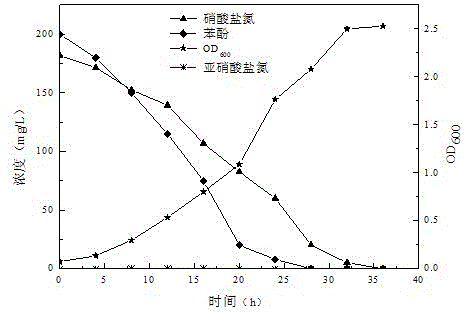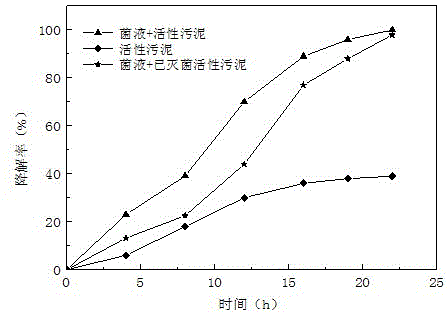Phenol-resistant heterotrophic nitrification-aerobic denitrification strain and applications thereof
A technology of aerobic denitrifying bacteria and heterotrophic nitrification, applied in the directions of bacteria, chemical instruments and methods, biochemical equipment and methods, etc., can solve the problems of low ammonia nitrogen degradation efficiency, and achieve the effect of efficient degradation and good application prospects.
- Summary
- Abstract
- Description
- Claims
- Application Information
AI Technical Summary
Problems solved by technology
Method used
Image
Examples
Embodiment 1
[0021] Acinetobacter ( Acinetobacter sp.) Isolation, purification, identification and nitrification performance of Y3
[0022] 1. Isolation and purification of strains
[0023] (1) Source of bacteria
[0024] The bacteria source was collected from the activated sludge of the coking wastewater biological treatment system of Wuhan Iron and Steel Co., Ltd.
[0025] (2) Isolation and purification of strains
[0026] The collected activated sludge was placed in a refrigerator at 4°C, and 2 mL of the supernatant was inoculated into 100 mL of sterilized LB medium (peptone 1 wt%, sodium chloride 1 wt%, yeast extract 0.5 wt%), and 30 ℃, 250r / min activation culture overnight. Then take 2mL of the culture solution and transfer it to the sterilized heterotrophic nitrification medium, and so on, and gradually increase the concentration of ammonium sulfate during the transfer process (200 mg / L, 400 mg / L, 600 mg / L, 800 mg / L, / L). During acclimatization, 500 mg / L phenol was added...
Embodiment 2
[0039] Acinetobacter ( Acinetobacter sp.) Denitrification performance of Y3
[0040] Inoculate the strain Y3 in a sterile heterotrophic denitrification medium (containing 200 mg / L phenol), culture it at 30°C and 250 r / min, and take samples at regular intervals to detect the bacterial density (OD 600 ) and residual nitrate concentration, the results are as follows figure 2 shown. Depend on figure 2 It can be seen that the reproduction rate of strain Y3 is consistent with its denitrification rate. After 36 hours, the nitrate nitrogen with an initial concentration of 182 mg / L was completely degraded, and there was no accumulation of nitrite nitrogen during the denitrification process, and the denitrification was complete. . It shows that the strain still has good denitrification ability in the presence of phenol.
Embodiment 3
[0042] Acinetobacter ( Acinetobacter sp.) Degradation of ammonia nitrogen and phenol in coking wastewater of Y3
[0043] The bacterial suspension of strain Y3 was added to coking wastewater at an inoculation amount of 5vol%, and three groups of experiments were set up to investigate the removal effect of ammonia nitrogen and phenol in coking wastewater of strain Y3:
[0044] (a) Add 45mL of coking wastewater, 45mL of inorganic salt nitrification medium, 5mL of bacterial suspension and 5mL of unsterilized activated sludge into a 250mL Erlenmeyer flask;
[0045] (b) Add 45mL of coking wastewater, 45mL of inorganic salt nitrification medium, 5mL of bacterial suspension and 5mL of sterilized activated sludge into a 250mL Erlenmeyer flask;
[0046] (c) Add 45mL of coking wastewater, 50mL of inorganic salt nitrification medium and 5mL of activated sludge into a 250mL Erlenmeyer flask.
[0047] Place them in a shaker at 30°C and 250 r / min, and take samples at regular intervals to...
PUM
 Login to View More
Login to View More Abstract
Description
Claims
Application Information
 Login to View More
Login to View More - R&D
- Intellectual Property
- Life Sciences
- Materials
- Tech Scout
- Unparalleled Data Quality
- Higher Quality Content
- 60% Fewer Hallucinations
Browse by: Latest US Patents, China's latest patents, Technical Efficacy Thesaurus, Application Domain, Technology Topic, Popular Technical Reports.
© 2025 PatSnap. All rights reserved.Legal|Privacy policy|Modern Slavery Act Transparency Statement|Sitemap|About US| Contact US: help@patsnap.com



